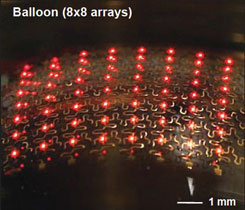 What is the first thing that comes to your mind when you hear LEDs? Yeah its the decorative lighting or lately an HDTV. But what may never had struck your mind is that LEDs could be used in future for betterment of human health.
What is the first thing that comes to your mind when you hear LEDs? Yeah its the decorative lighting or lately an HDTV. But what may never had struck your mind is that LEDs could be used in future for betterment of human health.
Researchers in the US, China, Korea and Singapore have collaborated to develop flexible ultra-thin sheets of inorganic light emitting diodes (LEDs) and photodetectors for implantation under the skin for medical monitoring, activating photo-sensitive drugs, and other biomedical applications.
John Rogers from the University of Illinois at Urbana-Champaign is leading the Research project and has demonstrated best ever implantable LED array.
Efforts are to insert LED lights under the human skin. The attempt isn’t new but this one has higher promises than anything that has been showcased so far. With unique ability of stretching and twisting by as much as 75 percent, encased in thin silicon rubber (making it waterproof), makes it idealistic for under the skin operations.
How Implanted LEDs can help in Treatments
Basically, it’s a green light to subdermal illumination, which could aid such things as monitoring the healing of wounds, activating light-sensitive drug delivery, spectroscopy, and even robotics. They could also be used in light-emitting sutures or implantable illuminated plasmonic crystals, and may find application in robotics.
The researchers successfully tested the LEDs by integrating a sheet into the fingertip of a vinyl glove, which they then immersed in soapy water, and they have also implanted an array beneath the skin in an animal model.
How its made possible
The technology enables production of Flexible arrays 2.5 μm thick and 100 x 100 μm square. The circuits are printed directly onto a rigid glass substrate and then transferred them to an inexpensive biocompatible polymer called poly(dimethylsiloxane) (PDMS) to create a mesh-like array of LEDs and photodetectors.
The PDMS substrate is flexible enough that the circuits can still function even if twisted or stretched by even as much as 75 percent. Rogers said most research has concentrated on organic LEDs (OLEDs), which are extremely sensitive to water and oxygen.
We write about Google, Twitter, Open Source, Programming, Web, Apple, iPhone, Android and latest in Tech @taranfx on Twitter or by subscribing below:
loading...
loading...

